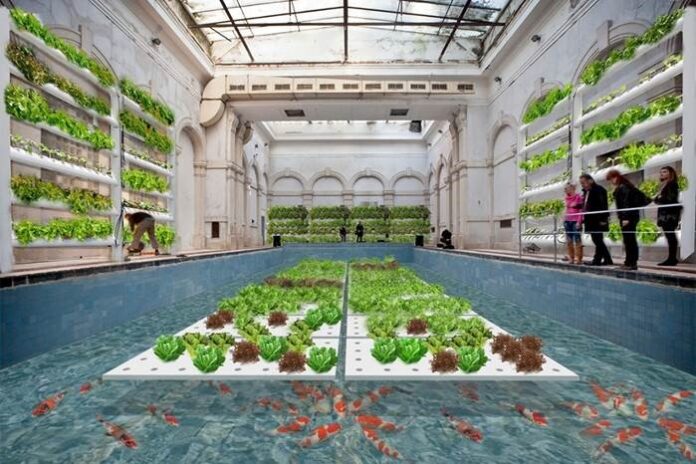Aquaponics, the fusion of aquaculture and hydroponics within a symbiotic water-based system, has witnessed significant growth in the global market. According to a study conducted by Persistence Market Research, the market for aquaponics market experienced a robust Compound Annual Growth Rate (CAGR) of 7.2% from 2018 to 2022, culminating in a valuation of US$ 54.8 million in 2023. This innovative system involves cultivating a diverse range of fish species including goldfish, carp, tilapia, and more, alongside plants such as chives and lettuce.
The waste produced by the fish is converted into nitrates and ammonia, which are detrimental to the aquatic environment but serve as vital nutrients for plant growth, creating a sustainable ecosystem. Projections indicate a further increase in sales, with the aquaponics market expected to grow at a CAGR of 7.4%, aiming to reach a market size of US$ 111.9 million by the conclusion of 2033.
Key market growth factors:
Sustainability: Aquaponics offers a sustainable method of food production by utilizing resources efficiently. The closed-loop system minimizes water usage and waste, making it an environmentally friendly alternative to traditional farming methods.
Increased Demand for Organic Produce: With a growing awareness of health and environmental concerns, consumers are increasingly seeking organic and locally sourced produce. Aquaponics provides a means of producing fresh, organic vegetables and fish without the use of synthetic pesticides or fertilizers.
Rising Population and Food Security Concerns: As the global population continues to expand, there is a growing need for innovative agricultural practices to ensure food security. Aquaponics offers a solution by maximizing yield in limited space and reducing reliance on arable land.
Technological Advancements: Advances in aquaponic systems, automation, and monitoring technology have made it easier and more efficient to manage and scale operations. This has lowered barriers to entry and expanded the market potential for aquaponics.
Increasing Awareness and Education: Education and outreach efforts about the benefits of aquaponics have contributed to its growing popularity among farmers, entrepreneurs, and consumers. As understanding of the system’s advantages spreads, adoption rates are likely to increase further.
Market Restraints
Initial Investment Costs: Setting up an aquaponics system can require a significant upfront investment in infrastructure, equipment, and technology. High initial costs may deter potential investors or small-scale farmers from adopting aquaponics, particularly in regions with limited financial resources.
Technical Complexity: Aquaponics systems require a certain level of technical expertise to design, operate, and maintain effectively. The complexity of managing water quality, nutrient levels, and the symbiotic relationship between fish and plants may pose challenges for newcomers to the industry.
Regulatory Challenges: Regulatory frameworks governing aquaponics vary across jurisdictions and may present obstacles to market expansion. Compliance with environmental regulations, food safety standards, and aquaculture licensing requirements can add complexity and costs to operations.
Opportunities
Expansion of Urban Agriculture: Aquaponics systems are well-suited for urban environments where arable land is limited. As urbanization continues to rise globally, there is a growing opportunity to integrate aquaponics into urban agriculture initiatives, enabling local food production and reducing the carbon footprint associated with food transportation.
Integration with Smart Agriculture Technologies: Advancements in IoT (Internet of Things), sensors, and automation technologies offer opportunities to enhance the efficiency and productivity of aquaponics systems. Integrating smart agriculture solutions can optimize resource usage, monitor environmental conditions, and automate tasks, leading to higher yields and lower operating costs.
Development of Specialized Products: Aquaponics allows for the production of a wide range of crops and fish species, including specialty varieties that cater to niche markets. There is an opportunity to capitalize on consumer demand for organic, locally sourced, and sustainably produced food by cultivating unique and high-value products through aquaponics.
Collaboration and Knowledge Sharing: Collaboration among industry stakeholders, including researchers, farmers, technology providers, and policymakers, can accelerate innovation and market development. Opportunities for knowledge sharing, research partnerships, and industry forums can drive advancements in aquaponics techniques, address common challenges, and promote best practices.
Top Regional Markets
Aquaponics finds a lucrative market in India due to its significant presence in vegetable product cultivation. India leads in aquaponics consumption within the South Asia and Pacific region, accounting for over 30% of the market share. Notably, the cultivation of tomatoes is poised for rapid growth, with an estimated value Compound Annual Growth Rate (CAGR) of 7.6%.
In the United States, there is a notable demand for aquaponics products, particularly in the agricultural sector. North America commands approximately 40% of the global market share, with the United States alone accounting for about 95% of the North American market. Tilapia fish emerges as the most sought-after product, with a valuation of approximately US$ 3.0 million in 2022. This demand is projected to continue growing at a rate of approximately 9.2% CAGR.
Key Recent Developments
Technological Advancements: There have been significant advancements in aquaponics technology, including the development of automated monitoring systems, optimized nutrient delivery systems, and improved aquaculture techniques. These advancements enhance system efficiency, productivity, and sustainability.
Market Expansion: The aquaponics market has witnessed expansion into new geographical regions, driven by increasing awareness of sustainable farming practices and growing demand for locally sourced, organic produce. Emerging markets in Asia, Africa, and Latin America are experiencing rapid growth in aquaponics adoption.
Investment and Funding: There has been a notable increase in investment and funding for aquaponics startups and projects, reflecting growing investor interest in sustainable agriculture and food security solutions. Venture capital firms, impact investors, and government initiatives are supporting the growth of the aquaponics industry through grants, subsidies, and research funding.
Commercialization and Scaling: Commercial aquaponics operations are scaling up production and diversifying product offerings to meet growing market demand. Large-scale aquaponics farms are supplying fresh produce to supermarkets, restaurants, and foodservice providers, demonstrating the commercial viability of aquaponics as a sustainable farming method.








